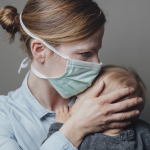Post-traumatic stress disorder (PTSD) is common among women of child-bearing age. While we are increasingly attentive to screening for depressive symptoms during pregnancy and after delivery, less often do we inquire about PTSD symptoms. Postpartum or childbirth-related PTSD (CB-PTSD) is not uncommon and may be precipitated by a stressful or traumatic childbirth experience. Sharon Dekel, PhD, Director of the Postpartum Traumatic Stress Disorders Research Program at Mass General, and her team have found that while childbirth-related PTSD may emerge after deliveries associated with more severe medical complications or death of the infant (stillbirth); PTSD may also occur after what many would consider an uncomplicated delivery.
In fact, as many as 17% of women in community samples experience CB-PTSD symptoms, even after giving birth to a healthy full-term baby (Dekel et al, 2017).
Childbirth-related PTSD can become an enduring and debilitating condition; however, we do not routinely screen for this condition and do not have validated tools to rapidly and efficiently screen for childbirth-related PTSD. Dekel and her team have been examining how the use of written personal narrative accounts of childbirth experiences can be used to identify women with childbirth-related post-traumatic stress disorder. In order to do this, they have developed a model based on natural language processing (NLP) and machine learning algorithms to identify childbirth-related PTSD. NLP is a branch of artificial intelligence that uses algorithms and techniques such as machine learning and text analytics to interpret and analyze natural language content from narratives, documents, and other sources.
Using Natural Language Processing to Identify Individuals with CB-PTSD
In an exploratory study, Bartal and colleagues (2023) analyzed narratives provided by women who had given birth within the last six months and who were enrolled in a survey study taking place during the COVID-19 pandemic. A total of 1,127 participants completed an anonymous internet-based survey and provided information about their mental health and childbirth experiences. At the end of this survey, participants were given the opportunity to provide a short written childbirth narrative account in which they were instructed to focus on the most distressing aspects of their childbirth experience. This approach is a commonly used strategy for studying trauma sequelae in non-postpartum samples. The PTSD Checklist for DSM-5 (PCL-5 with a cutoff score of 31) was used to identify women with CB-PTSD.
The researchers observed that women with childbirth-related PTSD tended to generate longer narratives and used more negative emotional expressions and death-related words in describing their childbirth experience compared to those without CB-PTSD. Machine learning was used to build, train and test different models derived from natural language processing using the collected childbirth narratives. They were able to generate a model that achieved good performance (area under the curve, 0.75; F1 score, 0.76; sensitivity, 0.8; specificity, 0.70). The area under the curve or AUC reflects a test’s ability to discriminate between cases and non-cases. In general, an AUC of 0.7 to 0.8 is considered to be acceptable. In a subsequent study (Bartal et al, 2024), they were able to improve the performance of the model, with an AUC of 0.8.
Clinical Implications
The studies from Dekel’s team indicate that personal narratives of the childbirth experience can be analyzed using advanced computational methods and can be utilized to identify women with CB-PTSD with relatively high accuracy. Thus, birth experience narratives could be a promising tool for maternal mental health screening. While universal screening with an instrument like the PTSD Checklist for DSM-5 (PCL-5) could also be used to identify women with PTSD related to childbirth, Dekel and her team argue that personal narratives may have specific advantages in this setting.
For those who have experienced a traumatic event, the narrative style and language that individuals use when recounting traumatic events may provide deeper insights into their mental well-being. Research has shown that the way in which individuals remember and describe traumatic events is connected to the expression of their post-traumatic stress symptoms. In fact, certain linguistic features captured in narratives obtained immediately after a traumatic event reflect an individual’s vulnerability to PTSD and depression, even before cognitive processing of the event has occurred.
Collection of short written childbirth accounts could take place remotely, potentially ahead of a medical visit. This strategy would aid in the identification of those at high risk for CB-PTSD but would also help to facilitate discussion of a potentially difficult or painful experience. Because CB-PTSD might occur in the context of what medical professionals would consider a “normal” or uncomplicated pregnancy, providers may not be aware of their patients’ subjective experiences and this approach may help to facilitate conversation.
Although early and mass screening for CB-PTSD would likely improve diagnosis rates and facilitation of treatment, there is no recommended medical protocol for CB-PTSD screening in hospitals and health clinics. The opportunity to screen women when they are still in contact with obstetrical providers is important, as such contact seems much more difficult to establish later, when disorders can become chronic and often comorbid and, hence, more difficult to treat. Establishing the potential accuracy of noninvasive and low-cost data collection based on childbirth narratives for the identification of women with CB-PTSD could serve as an important first step to complement more extensive clinical assessments and biologically oriented methods.
Our strategy of assessing childbirth narratives permitted the possibility of introducing an assessment with minimal burden during an acute period of rapid physiological and psychological adjustment. NLP analysis of subject-generated text is starting to be used for disease diagnosis in research contexts, and its application to detect CB-PTSD is novel. Our strategy may have the potential to be readily implemented in routine obstetrical care and may warrant developing a commercial model to facilitate widespread adoption. In addition, the racial and ethnic disparities related to childbirth-associated trauma remain to be explored in detail. Our model has the potential to improve the risk assessment of CB-PTSD, particularly in minority populations, by accounting for these considerations.
Free-text analysis using machine learning (ML)-based natural language processing (NLP) shows promise for diagnosing psychiatric conditions. Chat Generative Pre-trained Transformer (ChatGPT) has demonstrated preliminary initial feasibility for this purpose; however, whether it can accurately assess mental illness remains to be determined. This study evaluates the effectiveness of ChatGPT and the text-embedding-ada-002 (ADA) model in detecting post-traumatic stress disorder following childbirth (CB-PTSD), a maternal postpartum mental illness affecting millions of women annually, with no standard screening protocol.
The researchers used a sample of 1,295 women who had given birth in the last six months and were at least 18 years of age. The women were recruited through hospital announcements, social media, and professional organizations.
We explore ChatGPT’s and ADA’s potential to screen for CB-PTSD by analyzing maternal childbirth narratives. Contributors to this project include Alon Bartal, Kathleen Jagodnik, Sabrina Chan, Mrithula Babu, and Sharon Dekel.
Ruta Nonacs, MD PhD
References
Bartal A, Jagodnik KM, Chan SJ, Dekel S. AI and narrative embeddings detect PTSD following childbirth via birth stories. Sci Rep. 2024 Apr 11;14(1):8336.
Bartal A, Jagodnik KM, Chan SJ, Babu MS, Dekel S. Identifying women with postdelivery posttraumatic stress disorder using natural language processing of personal childbirth narratives. Am J Obstet Gynecol MFM. 2023 Mar;5(3):100834.
AI model has potential to detect risk of childbirth-related post-traumatic stress disorder (NIH Media Advisory)








Leave A Comment